People with respiratory conditions like chronic obstructive pulmonary disease (COPD) and chronic bronchitis often produce a large amount of mucus. If the mucus is allowed to collect in the airways, breathing may become difficult, and infection may occur. Review various techniques for adult and pediatric patients:
How to Cough Up Phlegm & Mucus to Relieve Chest Congestion in Adults
Techniques to cough up mucus are often done after using an inhaled bronchodilator medication. The medication helps loosen the mucus and open the airways to make the techniques more effective. Common techniques used to help remove mucus include these, which can be ordered and demonstrated by your doctor.
Deep Coughing: Start by taking a deep breath. Hold the breath for 2-3 seconds. Use your stomach muscles to forcefully expel the air. Avoid a hacking cough or merely clearing the throat. A deep cough is less tiring and more effective in clearing mucus out of the lungs.
Huff Coughing: Huff coughing, or huffing, is an alternative to deep coughing if you have trouble clearing your mucus. Take a breath that is slightly deeper than normal. Use your stomach muscles to make a series of three rapid exhalations with the airway open, making a "ha, ha, ha" sound. Follow this by controlled diaphragmatic breathing and a deep cough if you feel mucus moving.
Other Techniques: If you produce a large amount of mucus, your health care provider may recommend other techniques to help clear the mucus.
Devices such as the Acapella® or Aerobika® are small devices into which you exhale.
Postural drainage is a technique that uses gravity to promote drainage of mucus from the lungs.
Each technique can be ordered and demonstrated by your health care provider. Ask your health care provider if this may be helpful for you.
Exercise is also a good way to help bring up mucus in the lungs.
How to Remove Mucus from Lungs of Infants and Children
Manual Chest Physiotherapy
Infants and children with some lung conditions (bronchiectasis, primary ciliary dyskinesia, cystic fibrosis and other conditions) often produce a large amount of mucus. If the mucus is allowed to collect in the airways, breathing may become difficult, and infection may occur. Airway clearance measures, including chest physiotherapy, help clear the mucus. Chest percussion with huff or deep coughing can help clear the mucus in the lungs. Huff and deep coughing are described in more detail below.
The best technique for your child will be prescribed by your health care provider. Correct technique is very important. A member of your health care team will show you how to use these techniques. The team member will also observe your technique. It is also important to have your technique checked periodically to make sure you continue to use it correctly to obtain the most benefit. Chest percussion and coughing techniques are described in more detail below.
Manual Chest Percussion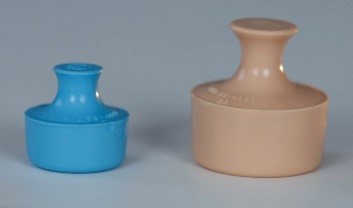
This is sometimes called clapping. A percussor device may also be used instead of bare hands. To the right is a picture of a small (blue or pink) and large (tan) percussor device.
Here's where a parent, family member or health care professional may help the infant or child. Your infant or child will lie in a number of positions, described below, for chest percussion.
Do chest percussion 30 minutes before or after eating.
Place a towel or T-shirt over the chest for comfort.
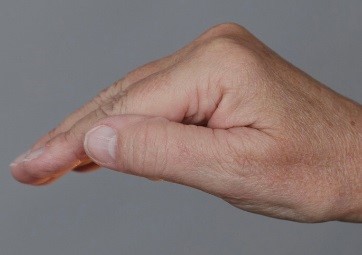 The helper will hold his or her hands in a relaxed, cupped position (see picture to the right). Do not slap with a flat hand. A percussor (pictured above the cupped hand) may be also be used.
The helper will hold his or her hands in a relaxed, cupped position (see picture to the right). Do not slap with a flat hand. A percussor (pictured above the cupped hand) may be also be used.
Keeping the wrists loose and moving the arms and elbow, clap over the rib cage, taking care not to hit directly over the heart, abdomen or kidneys.
Using a smooth rhythm, you should clap for about two minutes in each position.
Clapping should be firm, but not painful. When done correctly, this will make a popping sound. With a little practice, this technique is easy to master.
Chest Therapy Positions
These positions work with the natural effects of gravity to promote airway clearance. You can hold your infant in your lap for these positions. For children, pillows may be used to create the proper positions. Someone may help you with chest percussion (clapping).
Your child’s health care provider will show you which positions are best to use for your child.
| Sitting, leaning back (percuss upper chest on both sides) | 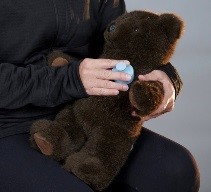 |
| Sitting, leaning slightly forward (percuss upper back on both sides) | 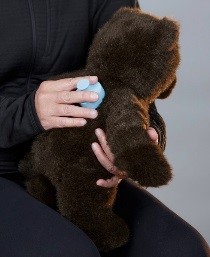 |
| Lying flat on back (percuss upper chest on both sides) | 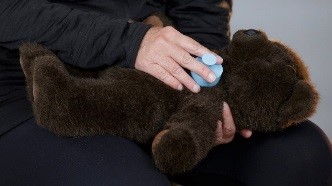 |
| On side (percuss over lower ribs on both sides) | 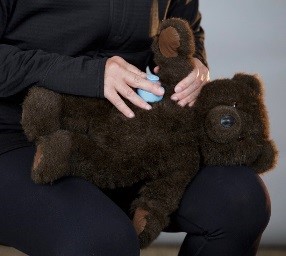 |
| On side, tilting forward, then backward (percuss over middle portion of rib cage on both sides) |  |
| Lying flat on stomach (percuss over middle and lower back on both sides) | 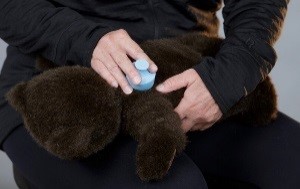 |
Remember, for children, pillows may be used on a couch or bed to create the proper positions.
Chest Wall Vibration
After each chest therapy position and percussion chest wall vibration may be performed. A parent, family member or health care professional will have to perform this therapy also. Vibration is performed in the same area as chest percussion. Your child stays in the positions (described above) during this therapy. Your child takes a deep breath in and then exhales. The helper holds his or her hand flat against the area of the lung to be drained and then produces a gentle shaking movement while the child exhales.
Coughing
After each chest therapy position and vibration, encourage your child to do several deep or huff coughs to help clear the mucus.
Deep coughing — If your child is able to do this, an effective cough is helpful to clear mucus. Your child takes a deep breath and holds the breath for 2-3 seconds. Then your child forcefully expels the air. Avoid a hacking cough or merely clearing the throat. A deep cough is less tiring and more effective in clearing mucus out of the lungs.
Huff coughing – Huff coughing is an alternative to deep coughing if your child has trouble clearing the mucus. Your child takes a breath that is slightly deeper than normal. Then your child makes a series of 3 rapid exhalations with the airway open, making a “ha, ha, ha” sound.
It is important to talk with your health care provider about the technique or techniques to bring up mucus that are best for your infant or child. If you are doing chest percussion, ask what positions which will work best for your infant or child. Remember, talk with your health care provider about your illness and developing techniques to bring up mucus that are best for your child.
 Clinical Trials
Clinical Trials


 The helper will hold his or her hands in a relaxed, cupped position (see picture to the right). Do not slap with a flat hand. A percussor (pictured above the cupped hand) may be also be used.
The helper will hold his or her hands in a relaxed, cupped position (see picture to the right). Do not slap with a flat hand. A percussor (pictured above the cupped hand) may be also be used.




